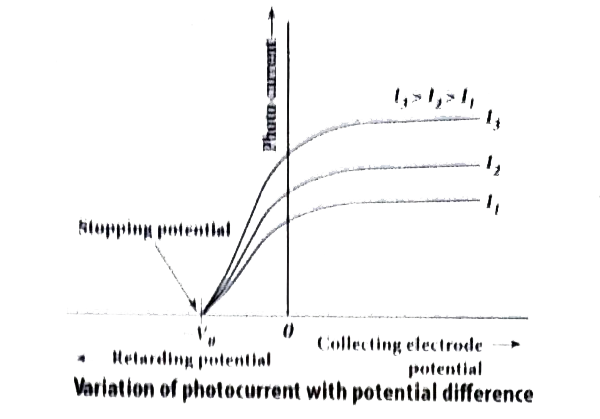Explain the effect of potential difference on photoelectric current. Solution in Tamil
Effect of potential difference on photoelectric current:
To study the effect of potential difference V between the electrodes on photoelectric current, the frequency and intensity of the incident light are kept constant. Initially the potential of A is kept positive with respect to C and the cathode is irradiated with the given light.
Now, the potential of A is increased and the corresponding photocurrent is noted. As the potential of A is increased, photocurrent is also increased. However a stage is reached where photocurrent reaches a saturation value (saturation current) at which all the photoelectrons from Care collected by A. This is represented by the flat portion of the graph between potential of A and photocurrent.

When a negative (retarding) potential is applied to A with respect to C, the current does not Immediately drop to vero because the photoelectrons are emitted with some definite and different kinetic energies.
• The kinetic energy of some of the photoolectrons is such that they could overcome the retarding electric field and rench the electrode A.
• When the negative (rotarding) potential of A is gradually increased, the photocurrent starts to decrease because more and more photoclectrons are being repelled away from reaching the electrode A. The photocurreunt becomes zero at a particular negative potential called stopping or cut-off potential
• Stopping potential is that the value of the negative (retarding) potential given to the collecting electrode A which is just sufficient to stop the most energetic photoelectrons emitted and make the photocurrent zero.
• Aribe stopping potential, even the most energetic electron is brought to rest. Therefore, the Initial kinetic energy of the fastest electron (kmax) is equal to the work done by the stopping potential to stop it (eV0)
Kmax=12mv2max=eV0.........(1)
where vmax is the maximum speed of the emitted photoelectron vmax=√2eV0m
vmax=√2×1.602×10−199.1×10−31×V0=5.93×105√V0.........(2)
From equation (1)
Kmax=eV0(in joule)(or)Kmax=V0(in eV)
• From the graph, when the intensity of the incident light alone is increased, the saturation current also increases but the value of V0 remains constant.
• Thus, for a given frequency of the incident light, the stopping potential is independent of intensity of the incident light. This also implies that the maximum kinetic energy of the photoelectrons is independent of intensity of the incident light.
Topper's Solved these Questions
Similar Questions
Write down Coulomb 's law in vector form and mention what each term represents .
View SolutionDerive an expression for electrostatic potential energy of the dipole in a uniform electric field .
View SolutionDefine capacitance . Give its unit.
View SolutionWhat is photoelectric effect? Explain experimentally the variation of photoelectric current with (i) the intensity of the incident light (ii) the potential difference between the plates and (iii) the frequency of the incident light and hence state the laws of photoelectric emission.
View SolutionExplain why the saturation current in photoelectric effect experiment with a light of one frequency and intensity is independent of the anode potential.
View SolutionIn photoelectric effect, the photoelectric current is independent of
View SolutionWhat is the effect of (i) intensity of light (ii) potential on photoelectric current ?
View SolutionHow did Einstein's photoelectric equation explain the effect of intensity and potential incident on photoelectric current ? How did this eqaution account for the effect of frequency of incident light on stopping potential ?
View SolutionExplain the effect of potential difference on photoelectric current.
View SolutionIn photoelectric effect , the curve between photoelectric current and anode potential V (for different frequencies ) is shown in figure , then
View SolutionWhy wave theory of light could not explain the photoelectric effect ? State two reasons. Draw graph between anode potential vs photoelectric current .
View SolutionExplain effect of potential on photoelectric current.
View SolutionWhat is photoelectric effect ? Explain effect of intensity on photoelectric current.
View SolutionExplain the effect of potential difference on photoelectric current.
View SolutionExplain effect of potential on photoelectric current in experiment of photoelectric effect.
View Solution
